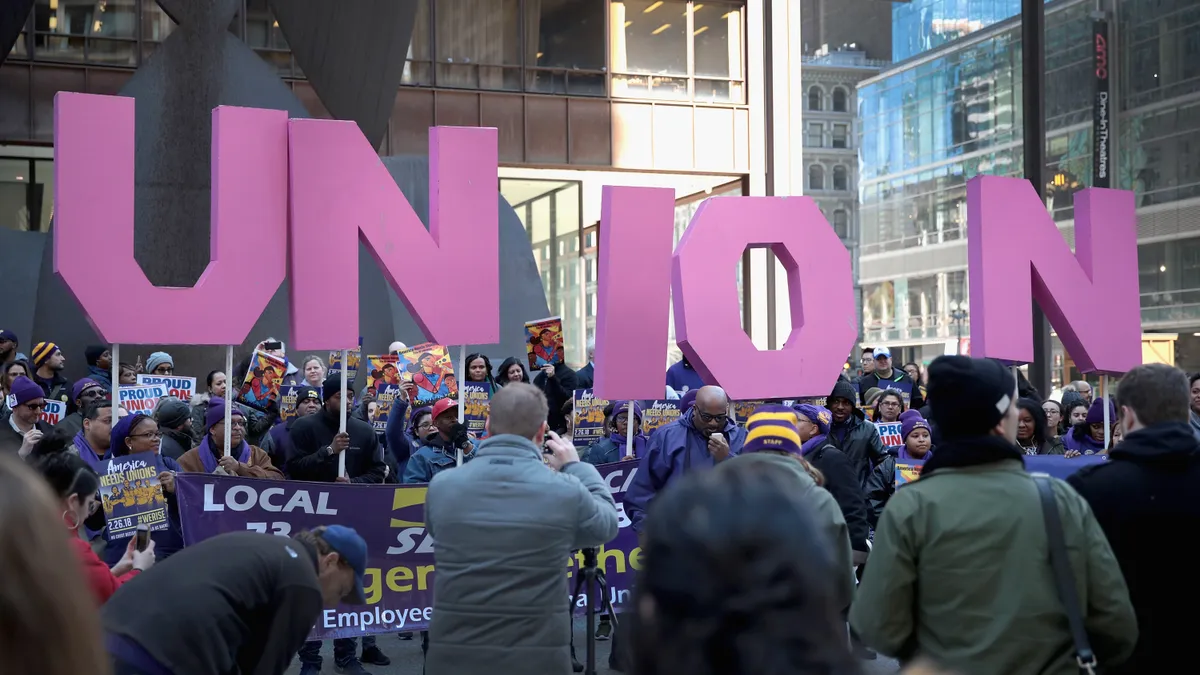Dive Brief:
- The share of U.S. workers with union membership fell to a record low last year even as labor organizers scored high-profile wins at Microsoft, Starbucks, Amazon.com and other companies.
- Among wage and salary workers, 10.1% were members of unions last year compared with 10.3% in 2021 and 20.1% in 1983, the Labor Department said. Unions lost ground proportionally in 2022 as the total number of workers grew by 5.3 million, or 3.9%.
- “On average, industries and occupations with low rates of unionization are growing faster than ones with high rates of unionization,” according to Gad Levanon, chief economist at the Burning Glass Institute. Also, employees at new businesses may be less likely to be unionized than older ones.
Dive Insight:
Unions have failed to stem both a long-term decline in proportional membership and an erosion in real wages. Indeed, in recent years “the wages of non-union workers have been rising much faster than for union workers,” Levanon said, citing Labor Department data.
For all workers real average hourly earnings fell 1.7% last year as the consumer price index surged 6.5%.
At first glance, CFOs and their C-suite colleagues would appear to be at a disadvantage when negotiating compensation with both unionized and non-unionized workers.
Unemployment fell last month to 3.5%, tying a pre-pandemic low. Demand for workers far exceeds supply, with 1.7 openings available for every job seeker as of November.
Also, employees are jumping ship at near-record levels to seize on better pay and benefits elsewhere. The quits rate, or the number of workers who left their jobs as a percent of total employment, has wavered since March 2021 between 2.6% and 3%, the highest rate since 2000, according to the Labor Department.
Still, compensation trends during the past several months have set back labor, Fed Vice Chair Lael Brainard said in a speech on Thursday, noting a decline in real wages among middle- and higher-wage workers.
“Overall, the labor share of income has declined over the past two years and appears to be at or below pre-pandemic levels, while corporate profits as a share of GDP [gross domestic product] remain near postwar highs,” Brainard said.
Labor organizers face persistent headwinds, Levanon said, noting growth in the “gig economy” and the work-from-home option at many companies.
“My guess is that the shift to remote work reduces the social interactions among coworkers and camaraderie that may be important for successful efforts to unionize,” he said in an email response to questions. “It is really hard to find any industry or occupation that experienced a clear upward trend in unionization in recent years.”
A recession and softening in the labor market — expected in 2023 by many economists — would likely weaken the hand of labor in negotiations over pay and benefits, Levanon said. “That has been the typical pattern in recorded history.”
The jobless rate will probably increase this year, New York Fed President John Williams said in a speech Thursday. The most aggressive monetary tightening in four decades will likely slow the economy and cool the labor market, pushing up unemployment in 2023 to about 4.5%, he said.












